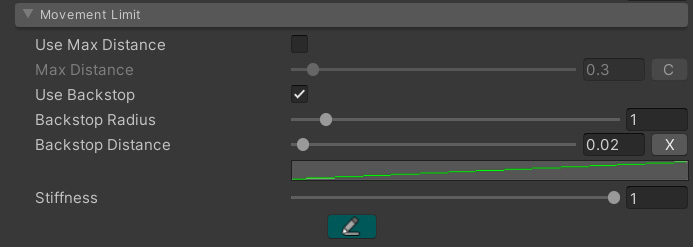Movement restrictions
Limits the range in which vertices can move based on the animation pose vertex normals.
This is also called a backstop.
By using this function, you can easily prevent bangs from entering your head.
It can also prevent T-shirts and other items from entering the human body.
The mechanism is simple, the processing load is low, and it is a system that can strongly prevent intrusion into the human body.
See Setting Backstops for more information.
| Use Max Distance | Whether or not to use a maximum distance limit. |
| Max Distance | The maximum distance that can be moved from the animation pose vertex. |
| Use Backstop | Whether or not the backstop function is used. |
| Backstop Radius | The radius of the backstop collision sphere. |
| Backstop Distance | The distance from the animation pose vertex to the backstop collision sphere. This is the opposite direction of the normal. |
| Stiffness | Repulsive force. A lower value will return softly at the limit. |
The figure above shows the configuration properties and their limits.
The proxy mesh’s vertices and normals show the animation pose, not the current translation position.
First, vertices can only move inside a sphere centered at the origin with a radius of Max Distance.
This is the first limitation.
Vertices can then only move outside the Backstop Collision sphere with a radius of Backstop Radius at a distance of Backstop Distance against the origin normal.
This is the second limitation.
These two restrictions mean that vertices can only move within the Max Distance and outside the Backstop Collision.
You can use both or just one side of this restriction.
Paint Range
You can paint whether or not to use the limit function per vertex.
This is done via the blue pen mark button.


